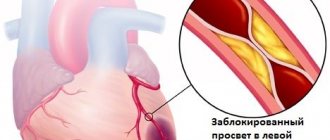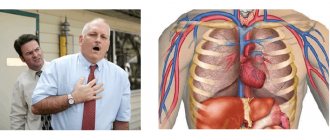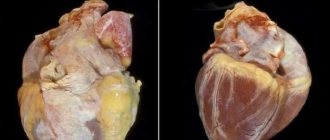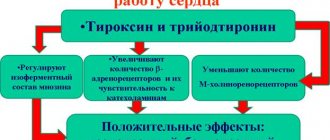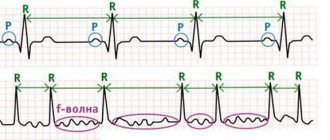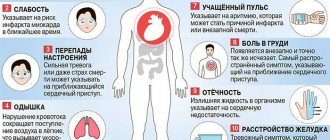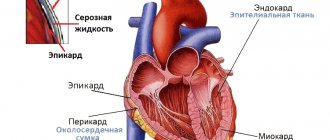Svetlana Shcherbakova
Cardiologist
Higher education:
Cardiologist
Kabardino-Balkarian State University named after. HM. Berbekova, Faculty of Medicine (KBSU) Level of education – Specialist 1994-2000
Additional education:
“Cardiology”
State Educational Institution “Institute for Advanced Training of Physicians” of the Ministry of Health and Social Development of Chuvashia
Contacts
Physiological processes in the body are determined not only by internal biochemistry - they are also influenced by external factors. Changes in body temperature, breathing rate and heart rate are a natural reaction to the external environment, stress, and psycho-emotional state. Cardiac activity directly depends on the momentary state of a person.
Sports, physical work, and stress make the heart beat faster, as muscles and nerve tissues require more oxygen. At rest, the heart returns to its normal rhythm. Irregular heart rhythm can also be a response. When should you be concerned and contact a cardiologist?
What is sinus rhythm
Sinus heart rhythm means normal heart function. The electrical impulses that cause the heart to contract and pump blood evenly come from the right place - the sinus node, located in the upper part of the right atrium. Pulses are generated at regular intervals. The heart rate (HR) for a healthy adult at rest is 60–90 beats per minute. This is called regular sinus rhythm.
Deviations from the genetically determined mode of cardiac activity are called arrhythmias. Rhythm disturbances occur in different parts of the heart muscle - in the atria, ventricles and septa. If the cause is a malfunction of the sinoatrial node, then the arrhythmia is called sinus.
This is what sinus rhythm looks like on an ECG
Sinus tachycardia
Sinus tachycardia is an increase in heart rate to 100 beats per minute or more. In this case, the interval between contractions remains the same. During and immediately after physical or nervous stress, this condition is considered normal. At rest, the heartbeat returns to normal. If an increase in heart rate begins for no apparent reason, this indicates pathology.
Sinus bradycardia
A slow, uniform heartbeat occurs in physically trained people. With each beat, the heart pumps enough blood to fully supply the body with oxygen and nutrients. Therefore, a heart rate of 59–50 beats is the norm for them. The cause of pathological slow heartbeat is certain diseases that affect the functioning of the sinus node.
Sinus arrhythmia
The condition when the frequency of contractions remains normal (increased or decreased), but the intervals between them differ, is called sinus arrhythmia. The reason for its appearance in children and adolescents is uneven growth and development of organs or respiratory arrhythmia. Sinus arrhythmia as an isolated disease is more common in older people.
Diagnosis of coronary heart disease
Very important for diagnosing coronary heart disease is a thorough interview of the patient, as well as additional studies, including ECG and analysis of so-called liver enzymes, echocardiography. In addition, the presence of risk factors can help in making the correct diagnosis.
Sometimes it is necessary to perform angiography, which is an examination of the coronary arteries on a monitor screen using X-rays. Obtaining an image becomes possible after inserting a special catheter through the femoral artery through which a contrast agent is supplied.
Sinus arrhythmia - view on the ECG
Changes in the sinus rhythm of the heart sometimes do not manifest significant symptoms. But they are clearly visible on the ECG. Electrocardiography shows the parameters of the heart muscle - the uniformity and frequency of contractions, the conductivity of muscle fibers, the work of the cells that generate the impulse.
To do this, the doctor evaluates the teeth, intervals and segments on the displayed graph. What matters is their presence or absence, sequence, height, location and direction. Each parameter has a numerical value. Teeth are areas located above or below the isoline. They show moments of excitation and relaxation of the myocardium of different parts of the heart:
- P - wave, reflecting contraction and relaxation of the atria;
- Q, S - waves showing excitation of the septum between the ventricles;
- R—ventricular excitation parameter;
- T – the process of their relaxation.
The P-Q interval is the time it takes for an impulse to travel from the atrium to the ventricles. The QRS segment is the ventricular complex (reflects the excitation of the ventricles), T–P is the period of diastole (relaxation of the heart muscle). Heart rate is determined by RR intervals - their number in 3 seconds is multiplied by 20. Normally, this figure ranges from 60 to 90 contractions. If sinus rhythm is disturbed, the following changes are observed on the ECG:
| ECG indicators | Norm | Tachycardia | Bradycardia | Sinus arrhythmia |
| Heart rate | 60–90 | 100 and above | Less than 59 | - normal - tachycardia - bradycardia |
| P waves and QRS complexes | Correct alternation in all cycles | Correct alternation in all cycles | Correct alternation in all cycles | Correct alternation in all cycles |
| P waves | 1.5–2.5 mm | Amplitude increased | Amplitude reduced | Norm |
| PQ interval | 0.12–0.2 s | Shortened | Increased | Minor interval changes |
| RR intervals | Uniform, 0.15 s | Uniform | Uniform | Changes abruptly, lasting more than 0.15 s |
Sinus arrhythmia - physiological and pathological
Irregular sinus rhythm can be physiological and pathological. The cause of physiological arrhythmia is often the breathing process, which is inextricably linked with the work of the heart. When you inhale, it beats faster, and when you exhale, it slows down.
This irregular rhythm in some people is a feature of the body and occurs constantly. Physiological sinus arrhythmia does not interfere with blood circulation and does not affect cardiac activity in any way. Respiratory arrhythmia manifests itself:
- when overworked or in moments of stress;
- in childhood and adolescence;
- with vegetative-vascular dystonia;
- after severe infectious diseases.
Pathological sinus arrhythmia has cardiac and extracardiac causes. Cardiac - diseases or defects of the heart. Extracardiac origin is associated with other pathologies that disrupt the functioning of the heart - hypertension, viral infections, diseases of the lungs and thyroid gland. In older people, heart rhythm is affected by age-related changes. Bad habits, lack of potassium and magnesium, obesity are also possible causes of sinus arrhythmia.
Risk factors for coronary heart disease
- Age – the increased risk of developing coronary heart disease concerns men over 45 years of age and women over 55 years of age.
- Male gender – men risk of developing coronary heart disease than women. This is due to the protective effect of hormones in women during the reproductive period. After menopause, the risk of the disease in women increases significantly.
- Diseases in the family, if a person from close relatives (mother, father, brothers, sisters) is or is sick with coronary heart disease, the risk of the disease is higher. This is due to both genetic factors and lifestyle and eating habits or spending free time.
- Cigarette smoking, both active and passive (staying in a smoky room), significantly increases the risk of developing coronary heart disease. It turns out that stopping smoking leads to a 25% reduction in the risk of death from causes related to coronary heart disease.
- Elevated cholesterol levels – a high concentration of total cholesterol, and especially an increase in “bad” cholesterol and a decrease in “good” cholesterol, increases the risk of developing coronary heart disease. Currently, it is recommended that cholesterol levels should not exceed 190 mg/dL.
- Hypertension – People with high blood pressure (above 140/90 mmHg) have an increased risk of myocardial infarction and other cardiovascular complications (stroke).
- Diabetes mellitus – this disease accelerates the development of atherosclerosis, one of the main causes of coronary heart disease.
- Obesity and low physical activity.
- Stress.
Features of sinus arrhythmia in children
A child's heart rate is significantly different from an adult's. In newborns, the normal heart rate is between 120 and 170 beats per minute. With age, the heart rate decreases and reaches adult values by adolescence.
Doctors distinguish three types of arrhythmia - mild, moderate and severe. In moderate form, it occurs in children under 5 years of age and in adolescents. Severe bradyarrhythmia occurs after rheumatism or in children involved in sports.
The main causes of arrhythmias are congenital heart defects, endocrine pathologies, metabolic disorders (lack of microelements and impaired water-electrolyte metabolism). In some children, arrhythmia appears during periods of rapid growth - at 5–7 and at 9 years. In adolescence, it is caused by vegetative-vascular dystonia.
Each type of arrhythmia is characterized by certain threshold values of heart rate. Severe bradycardia in children under one year of age is a pulse less than 100 beats. In children from 2 to 7 years old, it is diagnosed with a heart rate of less than 75, from 8 to 18 years old - with a heart rate of less than 62 beats per minute. Severe tachycardia occurs when normal pulse values are exceeded by 40–60 beats.
Common symptoms for all types of sinus arrhythmias in children:
- fast fatiguability;
- intolerance to stuffiness;
- restless behavior (typical of children under one year old);
- poor appetite;
- pale skin;
- When counting the pulse, interruptions are heard (uneven rhythm).
Older children complain of headaches and morning dizziness. If these symptoms are observed continuously, the child should be examined by a cardiologist.
How to treat arrhythmia in a child
First of all, it is necessary to organize the child’s life in such a way as to minimize the risk of further development of the disease and complications. It is necessary to protect him from any conflicts in the family and reduce his time in front of the TV or computer. Daily long walks, balanced nutrition and physical activity will benefit your health.
Sinus arrhythmia in children is not treated with special medications. Usually it is symptomatic, and the efforts of doctors are aimed at correcting the underlying disease.
Treatment
Not all types of sinus arrhythmia need to be treated. Doctors distinguish two types - cyclic arrhythmia associated with breathing and non-cyclic or pathological. Cyclic arrhythmia is not treated, considering it physiological. In case of pathological arrhythmia, diagnostics are carried out to determine the cause of the rhythm disturbance. The choice of treatment depends on the type of pathology detected and the cause of its occurrence.
If heart failure is caused by chronic stress, the doctor prescribes sedatives. They improve sleep, relieve irritability and increased excitability. For nervous disorders, tranquilizers are used.
If the heart rhythm disturbance is organic and associated with changes in the heart muscle, antiarrhythmic drugs are prescribed. In addition to medications, the doctor gives recommendations:
- make changes to your diet - give up junk food, strong tea and coffee, sweets and alcohol;
- normalize weight (for obesity);
- use traditional medicine.
A patient with sinus bradyarrhythmia less than 40 beats per minute requires implantation of a pacemaker. Often arrhythmia is symptomatic, that is, it is a consequence of another disease. After it is cured, cardiac activity returns to normal, and the risk of complications tends to zero.
Causes of coronary heart disease
Coronary heart disease can be caused by various reasons, including primary and secondary factors.
The primary causes are changes in the coronary arteries, which impede the flow of blood and therefore the delivery of oxygen to the heart muscle cells. Secondary causes include cases where there is no evidence of organic changes in the coronary arteries.
Primary causes of coronary heart disease
- Atherosclerosis of the coronary arteries is responsible for almost 98% of all cases of coronary heart disease. Atherosclerosis is the process of formation of atherosclerotic plaques from lipids (cholesterol) and inflammatory cells in blood vessels. The growth of atherosclerotic plaques leads to compression of the lumen of blood vessels, which ultimately can even lead to its closure. Often the cause of sudden closure of a vessel is plaque rupture.
- Narrowing of the coronary arteries can be caused by a number of diseases, sometimes affecting the entire body, such as syphilis, Takayasu disease, Kawasaki disease, systemic lupus erythematosus, periarteritis, infectious diseases, scleroderma.
- Deposits in the walls of the coronary arteries of abnormal metabolic products in amyloidosis, mucopolysaccharidosis, homocystinuria, Fabry disease, idiopathic arterial calcification in a newborn.
- Thrombosis of the coronary arteries - is associated mainly with bacterial infection or the presence of bacteria in the blood, infectious inflammation of the endocardium, the presence of a blood clot in the left atrium or left chamber of the heart, as well as on the surface of catheters inserted into the heart (as a complication during treatment and diagnostic procedures), artificial heart valves.
- Congenital anomalies of the coronary arteries (underdevelopment of some coronary arteries or the arteries leaving the pulmonary artery rather than the aorta).
- Injuries that cause external narrowing of the coronary arteries (for example, painful shock after injury).
Secondary causes of coronary heart disease
- coronary artery spasm, the so-called Prinzmetal angina, which involves abnormal contraction of the walls of arteries that remain unchanged during the disease process;
- arterial spasm caused by the supradarteriovenous muscle;
- blood disorders (anemia, hypererythrocytosis);
- carbon monoxide poisoning;
- hypotension.
The most common cause of coronary heart disease is the deposition of atherosclerotic plaques in the coronary arteries. Cholesterol consumed in excess through food settles on the walls of the coronary arteries. A number of processes occur that cause damage to the walls of blood vessels. The body's response is to release substances that cause damage to heal, but at the same time they are sticky and attach to other substances (for example, calcium or protein molecules).
Fat and various substances, most notably cholesterol, begin to create plaques that narrow the path of blood flow to the heart. Some plaques are harder on the outside and soft on the inside. Others are fragile and fall apart easily. Atherosclerosis increases blood clotting, which enhances the formation of blood clots.
The resulting blood clot adheres to the plaque. Under some conditions, a blood clot can break off and cause narrowed blood vessels to close, causing congestion and therefore a sudden interruption of nutrition to the heart cells. Currently, atherosclerosis is considered a chronic inflammatory disease of large and medium-sized arteries.
